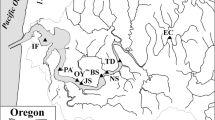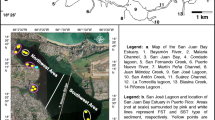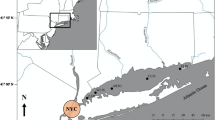Abstract
Sediment denitrification is a microbial process that converts dissolved inorganic nitrogen in sediment porewaters to N2 gas, which is subsequently lost to the atmosphere. In coastal waters, it represents a potentially important loss pathway for fixed nitrogen which might otherwise be available to primary producers. Currently, data are lacking to adequately assess the role of denitrification in reducing or remediating the effects of large anthropogenic nitrogen loads to the coastal zone. This study describes the results of 88 individual measurements of denitrification (as a direct flux of N2 gas) in sediment cores taken over a 3-yr period (1991–1994) from six stations in Boston Harbor, nine stations in Massachusetts Bay, and two stations in Cape Cod Bay. The dataset is unique in its extensive spatial and temporal coverage and includes the first direct measurements of denitrification for North Atlantic shelf sediments. Results showed that rates of denitrification were significantly higher in Boston Harbor (mean=54, range<5–206 μmol N2 m−2 h−1) than in Massachusetts Bay (mean=23, range<5–64 μmol N2 m−2 h−1). Highest rates occurred in areas with organic-rich sediments in the harbor, with slower rates observed for low-organic sandy sediments in the harbor and at shallow shelf stations in the bay. Lowest rates were found at the deepest shelf stations, located in Stellwagen Basin in Massachusetts Bay. Observed rates were correlated with temperature, sediment carbon content, and benthic macrofaunal activity. Seasonally, highest denitrification rates occurred in the summer in Boston Harbor and in the spring and fall in Massachusetts Bay, coincident with peak phytoplankton blooms in the overlying water column. Despite the fact that sediment denitrification rates were high relative to rates reported for other East Coast estuaries, denitrification losses accounted for only 8% of the annual total nitrogen load to Boston Harbor, a consequence perhaps, of the short water-residence times (2–10 d) of the harbor.
Similar content being viewed by others
Literature Cited
Alber, M. andA. Chan. 1994. Sources of contaminants to Boston Harbor: Revised loading estimates. Massachusetts Water Resources Authority Environmental Quality Department Technical Report Series No. 94-1. Massachusetts Water Resources Authority, Boston, Massachusetts.
Alber, M., J. Hallam, andM. S. Connor. 1993. The state of Boston Harbor 1992. Massachusetts Water Resources Authority. Environmental Quality Department Technical Report Series No. 93-6. Massachusetts Water Resources Authority, Boston, Massachusetts.
Andersen, T. K., M. H. Jensen, andJ. Sørensen. 1984. Diurnal variation of nitrogen cycling in coastal marine sediments.Marine Biology 83:171–176.
Binnerup, S. J., K. Jensen, N. P. Revsbech, M. H. Jensen, andJ. Sørensen. 1992. Denitrification, dissimilatory reduction of nitrate to ammonium, and nitrification in a bioturbated estuarine sediment as measured with 15N and microsensor techniques.Applied Environmental Microbiology 58:303–313.
Blake, J. A., B. Hilbig, andD. C. Rhoads. 1993. Soft-bottom benthic biology and sedimentology: 1992 baseline conditions in Massachusetts and Cape Cod bays. Massachusetts Water Resources Authority Environmental Quality Department Technical Report Series No. 93-10. Massachusetts Water Resources Authority, Boston, Massachusetts.
Boynton, W. R., J. H. Garber, R. Summers, andW. M. Kemp. 1995. Inputs, transformations, and transport of nitrogen and phosphorus in Chesapeake Bay and selected tributaries.Estuaries 18:285–314.
Christensen, J. P. 1994. Carbon export from continental shelves, denitrification and atmospheric carbon dioxide.Continental Shelf Research 14:547–576.
Christensen, J. P., J. W. Murray, A. H. Devol, andL. A. Codispoti. 1987. Denitrification in continental shelf sediments has major impact on the oceanic nitrogen budget.Global Biogeochemical Cycles 1:97–116.
Devol, A. H. andJ. P. Christensen. 1993. Benthic fluxes and nitrogen cycling in sediments of the continental margin of the eastern North Pacific.Journal of Marine Research 51:345–372.
Galloway, J. N., R. W. Howarth, A. F. Michaels, S. W. Nixon, J. M. Prospero, andF. J. Dentener. 1996. Nitrogen and phosphorus budgets of the North Atlantic Ocean and its watershed.Biogeochemistry 35:3–25.
Giblin, A. E., C. S. Hopkinson, andJ. Tucker. 1997. Benthic metabolism and nutrient cycling in Boston Harbor, Massachusetts.Estuaries 20:346–364.
Giblin, A. E., C. Hopkinson, J. Tucker, B. Nowicki, andJ. R. Kelly. 1994. Metabolism, nutrient cycling and denitrification in Boston Harbor and Massachusetts Bay sediments in 1993. Massachusetts Water Resources Authority Environmental Quality Department Technical Report Series No. 94-5. Massachusetts Water Resources Authority, Boston, Massachusetts.
Giblin, A. E., C. Hopkinson, J. Tucker, B. Nowicki, andJ. R. Kelly. 1995. Metabolism, nutrient cycling and denitrification in Boston Harbor and Massachusetts Bay sediments in 1994. Massachusetts Water Resources Authority Environmental Quality Department Technical Report Series No. 95-13. Massachusetts Water Resources Authority, Boston, Massachusetts.
Howarth, R. W. 1988. Nutrient limitation of net primary production in marine ecosystems.Annual Review of Ecology and Systematics 19:89–110.
Jenkins, M. C. andW. M. Kemp. 1984. The coupling of nitrification and denitrification in two estuarine sediments.Limnology and Oceanography 29:609–619.
Jensen, M. H., T. K. Andersen, andJ. Sørensen. 1988. Denitrification in coastal bay sediment: Regional and seasonal variation in Aarhus Bight, Denmark.Marine Ecology Progress Series 48:155–162.
Jensen, M. H., E. Lomstein, andJ. Sørensen. 1990. Benthic NH +4 and NO −3 flux following sedimentation of a spring phytoplankton bloom in Aarhus Bight, Denmark.Marine Ecology Progress Series 61:87–96.
Jørgensen, B. B. andJ. Sørensen. 1985. Seasonal cycles of O2, NO3 and SO4 reduction in estuarine sediments: The significance of an NO3 reduction maximum in spring.Marine Ecology Progress Series 24:65–74.
Jørgensen, K. S. 1989. Annual pattern of denitrification and nitrate ammonification in estuarine sediment.Applied and Environmental Microbiology 55:1841–1847.
Jørgensen, K. S. andJ. Sørensen. 1988. Two annual maxima of nitrate reduction and denitrification in estuarine sediment (Norsminde Fjord, Denmark).Marine Ecology Progress Series 48:147–154.
Kelly, J. R. 1991. Nutrients and Massachusetts Bay: A synthesis of eutrophication issues. Massachusetts Water Resources Authority Environmental Quality Department Technical Report Series No. 91-10. Massachusetts Water Resources Authority, Boston, Massachusetts.
Kelly, J. R. 1997. Nitrogen flow and the interaction of Boston Harbor with Massachusetts Bay.Estuaries 20:365–380.
Kelly, J. R. andP. H. Doering. 1995. Metabolism in Boston Harbor, Massachusetts and Cape Cod Bays, MA (USA) during 1992–1994. Massachusetts Water Resources Authority Environmental Quality Department Technical Report Series No. 95. Massachusetts Water Resources Authority, Boston, Massachusetts.
Kelly, J. R. andR. K. Kropp. 1992. Benthic recovery following sludge abatement in Boston Harbor: Baseline survey 1991 and Spring survey 1992. Massachusetts Water Resources Authority Environmental Quality Department Technical Report Series No. 92. Massachusetts Water Resources Authority, Boston, Massachusetts.
Kelly, J. R. andB. L. Nowicki. 1993. Direct measurements of denitrification in Boston Harbor and Massachusetts Bay sediments. Massachusetts Water Resources Authority Environmental Quality Department Technical Report Series No. 93-3. Massachusetts Water Resources Authority, Boston, Massachusetts.
Kemp, W. M., P. Sampou, J. Caffrey, M. Mayer, K. Henriksen, andW. R. Boynton. 1990. Ammonium recycling versus denitrification in Chesapeake Bay sediments.Limnology and Oceanography 35:1545–1563.
Kieskamp, W. M., L. Lohse, E. Epping, andW. Helder. 1991. Seasonal variation in denitrification rates and nitrous oxide fluxes in intertidal sediments of the western Wadden Sea.Marine Ecology Progress Series 72:145–151.
Knebel, H. J. andR. C. Circe. 1995. Seafloor environments within the Boston Harbor-Massachusetts Bay sedimentary system: A regional synthesis.Journal of Coastal Research 11:230–251.
Knebel, H., R. R. Rendigs, andM. H. Bothner. 1991. Modern sedimentary environments in Boston Harbor, Massachusetts.Journal of Sedimentary Petrology 61:791–804.
Knowles, R. 1982. Denitrification.Microbiology Review 46:43–70.
Koike, I. andJ. Sørensen. 1988. Nitrate reduction and denitrification in marine sediments, p. 251–273.In T. H. Blackburn and J. Sørensen (eds.), Nitrogen Cycling in Coastal Marine Environments. John Wiley & Sons Ltd, Bristol, England.
Kristensen, E., M. H. Jensen, andR. C. Aller. 1991. Direct measurements of dissolved inorganic nitrogen exchange and denitrification in individual polychaete (Nereis virens) burrows.Journal of Marine Research 49:355–377.
Kropp, R. K. andR. J. Diaz. 1995. Infaunal community changes in Boston Harbor 1991–1994. Massachusetts Water Resources Authority Environmental Quality Department Technical Report Series No. 95-21. Massachusetts Water Resources Authority, Boston, Massachusetts.
Law, C. S. andN. J. P. Owens. 1990. Denitrification and nitrous oxide in the North Sea.Netherlands Journal of Sea Research 25:65–74.
Law, C. S., A. P. Rees, andN. J. P. Owens. 1991. Temporal variability of denitrification in estuarine sediments.Estuarine, Coastal, and Shelf Science 33:37–56.
Lohse, L., H. T. Kloosterhuis, W. V. Raaphorst, andW. Helder. 1996. Denitrification rates as measured by the isotope pairing method and by the acetylene inhibition technique in continental shelf sediments of North Sea.Marine Ecology Progress Series 132:169–179.
Lohse, L., J. F. P. Malschaert, C. P. Slomp, W. Helder, andW. van Raaphorst. 1993. Nitrogen cycling in North Sea sediments: Interaction of denitrification and nitrification in offshore and coastal areas.Marine Ecology Progress Series 101:283–296.
Nielsen, K., L. P. Nielsen, andP. Rasmussen. 1995. Estuarine nitrogen retention independently estimated by the denitrification rate and mass balance methods: A study of Norsminde Fjord, Denmark.Marine Ecology Progress Series 119:275–283.
Nixon, S. W. 1981. Remineralization and nutrient cycling in coastal marine ecosystems, p. 111–138.In B. J. Neilson and L. E. Cronin (eds.), Estuaries and Nutrients. Humana Press, Clifton, New Jersey.
Nixon, S. M., J. Ammerman, L. Atkinson, V. Berounsky, G. Billen, W. Boicourt, W. Boynton, T. Church, D. DiToro, R. Elmgren, J. Garber, A. Giblin, R. Jahnke, N. Owens, M. E. Q. Pilson, andS. Seitzinger. 1996. The fate of nitrogen and phosphorus at the land-sea margin of the North Atlantic Ocean.Biogeochemistry 35:141–180.
Nixon, S. W., S. L. Granger, andB. L. Nowicki. 1995. An assessment of the annual mass balance of carbon, nitrogen, and phosphorus in Narragansett Bay.Biogeochemistry 31:15–61.
Nowicki, B. L. 1994. The effect of temperature, oxygen, salinity, and nutrient enrichment on estuarine denitrification rates measured with a modified nitrogen gas flux technique.Estuarine, Coastal and Shelf Science 38:137–156.
Nowicki, B. L. andC. A. Oviatt. 1990. Are estuaries traps for anthropogenic nutrients? Evidence from estuarine mesocosms.Marine Ecology Progress Series 66:131–146.
Pelegri, S. P., L. P. Nielsen, andT. H. Blackburn. 1994. Denitrification in estuarine sediment stimulated by the irrigation activity of the amphipodCorophium volutator.Marine Ecology Progress Series 105:285–290.
Pilson, M. E. Q. andS. P. Seitzinger. 1996. Areas of shallow water in the North Atlantic.Biogeochemistry 35:227–233.
Rysgaard, S., N. Risgaard-Petersen, N. P. Sloth, K. Jensen, andL. P. Nielsen. 1994. Oxygen regulation of nitrification and denitrification in sediments.Limnology and Oceanography 39:1643–1652.
Ryther, J. H. andW. M. Dunstan. 1971. Nitrogen, phosphorus and eutrophication in the coastal marine environment.Science 171:1008–1013.
Seitzinger, S. P. 1987. Nitrogen biogeochemistry in an unpolluted estuary: The importance of benthic denitrification.Marine Ecology Progress Series 41:177–186.
Seitzinger, S. P. 1988. Denitrification in freshwater and coastal marine ecosystems: Ecological and geochemical significance.Limnology and Oceanography 33 (4, part 2):702–724.
Seitzinger, S. P. andA. E. Giblin. 1996. Estimating denitrification in North Atlantic continental shelf sediments.Biogeochemistry 35:235–260.
Seitzinger, S. P. andS. W. Nixon. 1985. Eutrophication and the rate of denitrification and N2O production in coastal marine sediments.Limnology and Oceanography 30:1332–1339.
Seitzinger, S. P., S. W. Nixon, andM. E. Q. Pilson. 1984. Denitrification and nitrous oxide production in a coastal marine ecosystem.Limnology and Oceanography 29:73–83.
Seitzinger, S., S. Nixon, M. E. Q. Pilson, andS. Burke. 1980. Denitrification and N2O production in near-shore marine sediments.Geochimica et Cosmochimica Acta 44:1853–1860.
Signell, R. P. andB. Butman. 1992. Modeling tidal exchange and dispersion in Boston Harbor.Journal of Geophysical Research 97:15,591–15,606.
Smith, C. J., R. D. DeLaune, andW. H. Patrick, Jr. 1985. Fate of riverine nitrate entering an estuary: I. Denitrification and nitrogen burial.Estuaries 8:15–21.
Valiela, I. 1995. Marine Ecological Processes. 2nd edition. Springer-Verlag, New York.
Valiela, I., J. Costa, K. Foreman, J. M. Teal, B. Howes, andD. Aubrey. 1990. Transport of groundwater-borne nutrients from watersheds and their effects on coastal waters.Biogeochemistry 10:177–197.
Van Raaphorst, W., H. T. Kloosterhuis, E. M. Berghuis, A. J. M. Gieles, J. F. P. Malschaert, andG. J. van Noort. 1992. Nitrogen cycling in two types of sediments of the southern North Sea (Frisian Front, Broadfourteens): Field data and mesocosm results.Netherlands Journal of Sea Research 28:293–316.
Yoon, W. B. andR. Benner. 1992. Denitrification and oxygen consumption in sediments of two south Texas estuaries.Marine Ecology Progress Series 90:157–167.
Zimmerman, A. R. andR. Benner. 1994. Denitrification, nutrient regeneration and carbon mineralization in sediments of Galveston Bay, Texas, USA.Marine Ecology Progress Series 114:275–288.
Author information
Authors and Affiliations
Corresponding author
Rights and permissions
About this article
Cite this article
Nowicki, B.L., Kelly, J.R., Requintina, E. et al. Nitrogen losses through sediment denitrification in Boston Harbor and Massachusetts Bay. Estuaries 20, 626–639 (1997). https://doi.org/10.2307/1352620
Received:
Accepted:
Issue Date:
DOI: https://doi.org/10.2307/1352620




